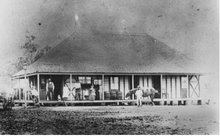Reading about ship voyages and looking at early death certificates, I have been having a crash course in infectious diseases. Last week I learnt about Bright’s disease. Today, it is the turn of “colonial fever.” Colonial fever is listed on many death certificates and has left some genealogists puzzled. People contracted this disease on board ship and also after arrival. It was common on the early goldfields and anywhere where there were large groups of people.
I have seen it defined as malaria, typhoid and typhus. I am sure too, that some doctors listed colonial fever when they were themselves not quite sure of the cause.
Typhoid is caused by a bacteria, Salmonella typhi, that is present in contaminated food or water. Symptoms include high fever, headache, weakness and fatigue, sore throat, abdominal pain, diarrhoea (in children) or constipation (in adults). In the second week, you get a rash. In the third week, you enter a state of delirium and exhaustion. In the fourth week, if you haven’t died from complications, improvement slowly starts although you may relapse up to two weeks later. Treatment includes antibiotics and intravenous fluids.
Typhus is an infectious disease spread by the bacteria, Rickettsia typhi and Rickettsia prowazekii. It is spread by lice or fleas and exposure to rat and other faeces. The first bacterium causes murine typhus which is rarely deadly. The second causes epidemic typhus which can be deadly. Symptoms include: severe headache, high fever, cough, muscle pain, low blood pressure, stupor, delirium, aversion to light and a spreading red rash. Modern treatment includes antibiotics, intravenous fluids and oxygen.
You can see that the two diseases could be easily confused. You can also see that without modern treatment methods, death would be a common end to infection. Most sources I have found online, state that colonial fever is typhus, probably the epidemic kind, that was spread by head and other lice and common on board ship. It would have been common too, where groups of new migrants congregated together, or where there was a continual inflow of migrants and their possessions off ships.
Subscribe to:
Post Comments (Atom)

No comments:
Post a Comment